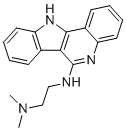
IQDMA
CAS No. 401463-02-3
IQDMA( C524250 | IQDMA cpd | IQDMA )
Catalog No. M14373 CAS No. 401463-02-3
A cell-permeable, small molecule inhibitor of the transcription factor STAT5.
Purity : >98% (HPLC)
 COA
COA
 Datasheet
Datasheet
 HNMR
HNMR
 HPLC
HPLC
 MSDS
MSDS
 Handing Instructions
Handing Instructions
| Size | Price / USD | Stock | Quantity |
| 5MG | 873 | Get Quote |


|
| 50MG | 1782 | Get Quote |


|
| 100MG | 2250 | Get Quote |


|
| 200MG | Get Quote | Get Quote |


|
| 500MG | Get Quote | Get Quote |


|
| 1G | Get Quote | Get Quote |


|
Biological Information
-
Product NameIQDMA
-
NoteResearch use only, not for human use.
-
Brief DescriptionA cell-permeable, small molecule inhibitor of the transcription factor STAT5.
-
DescriptionA cell-permeable, small molecule inhibitor of the transcription factor STAT5 that exhibits anticancer activity and inhibits the growth of A549, HL-60 and K562 cells with IC50 of 8, 5 and 8 uM, respectively.
-
In Vitro——
-
In Vivo——
-
SynonymsC524250 | IQDMA cpd | IQDMA
-
PathwayJAK/STAT Signaling
-
TargetSTAT
-
RecptorSTAT
-
Research Area——
-
Indication——
Chemical Information
-
CAS Number401463-02-3
-
Formula Weight304.397
-
Molecular FormulaC19H20N4
-
Purity>98% (HPLC)
-
Solubility——
-
SMILESCN(C)CCNC1=NC2=CC=CC=C2C3=C1C4=C(N3)C=CC=C4
-
Chemical NameN'-(11H-indolo[3,2-c]quinolin-6-yl)-N,N-dimethylethane-1,2-diamine
Shipping & Storage Information
-
Storage(-20℃)
-
ShippingWith Ice Pack
-
Stability≥ 2 years
Reference
1. Hu XW, et al. Cell Biol Toxicol. 2006 Nov;22(6):417-27.
2. Chien CM, et al. Chem Biol Interact. 2008 Oct 22;176(1):40-7.
3. Hodge LS, et al. Blood. 2014 Feb 13;123(7):1055-8.
molnova catalog



related products
-
BP-5-087
A potent, selective STAT3 SH2 domain inhibitor (EC50=5.6 uM) that reduces STAT3 phosphorylation and nuclear transactivation.
-
Quercetin pentaaceta...
Quercetin pentaacetate has diverse biological activities, including antioxidant, anti-inflammatory, and anticancer properties.
-
RSVA 405
RSVA 405 is an AMPK activator (EC50 = 1 μM), and is STAT3 inhibitor.



 Cart
Cart
 sales@molnova.com
sales@molnova.com


